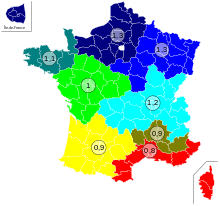Degree day

A degree day is a measure of heating or cooling. Total degree days from an appropriate starting date are used to plan the planting of crops and management of pests and pest control timing. Weekly or monthly degree-day figures may also be used within an energy monitoring and targeting scheme to monitor the heating and cooling costs of climate controlled buildings, while annual figures can be used for estimating future costs.
A degree day is computed as the integral of a function of time that generally varies with temperature. The function is truncated to upper and lower limits that vary by organism, or to limits that are appropriate for climate control. The function can be estimated or measured by one of the following methods, in each case by reference to a chosen base temperature:
- Frequent measurements and continuously integrating the temperature deficit or excess;
- Treating each day's temperature profile as a sine wave with amplitude equal to the day's temperature variation, measured from max and min, and totalling the daily results;
- As above, but calculating the daily difference between mean temperature and base temperature;
- As previous, but with modified formulae on days when the max and min straddle the base temperature.
A zero degree-day in energy monitoring and targeting is when either heating or cooling consumption is at a minimum, which is useful with power utility companies in predicting seasonal low points in energy demand.
Heating degree days are typical indicators of household energy consumption for space heating. The air temperature in a building is on average 2 °C to 3 °C higher than that of the air outside. A temperature of 18 °C indoors corresponds to an outside temperature of about 15.5 °C. If the air temperature outside is 1 °C below 15.5 °C, then heating is required to maintain a temperature of about 18 °C. If the outside temperature is 1 °C below the average temperature it is accounted as 1 degree-day. The sum of the degree days over periods such as a month or an entire heating season is used in calculating the amount of heating required for a building. Degree Days are also used to estimate air conditioning usage during the warm season.
See also
References
External links
| Wikimedia Commons has media related to Degree days maps. |
- Free heating and cooling degree days for locations worldwide
- Free degree day downloads for 77 UK weather stations and various building base temperatures
- How to use degree-day data for energy management
- Information relating to plant and pest growth
- Inaccuracies in degree-day-based energy calculations, and how to reduce them
- met Ireland - Degree Days